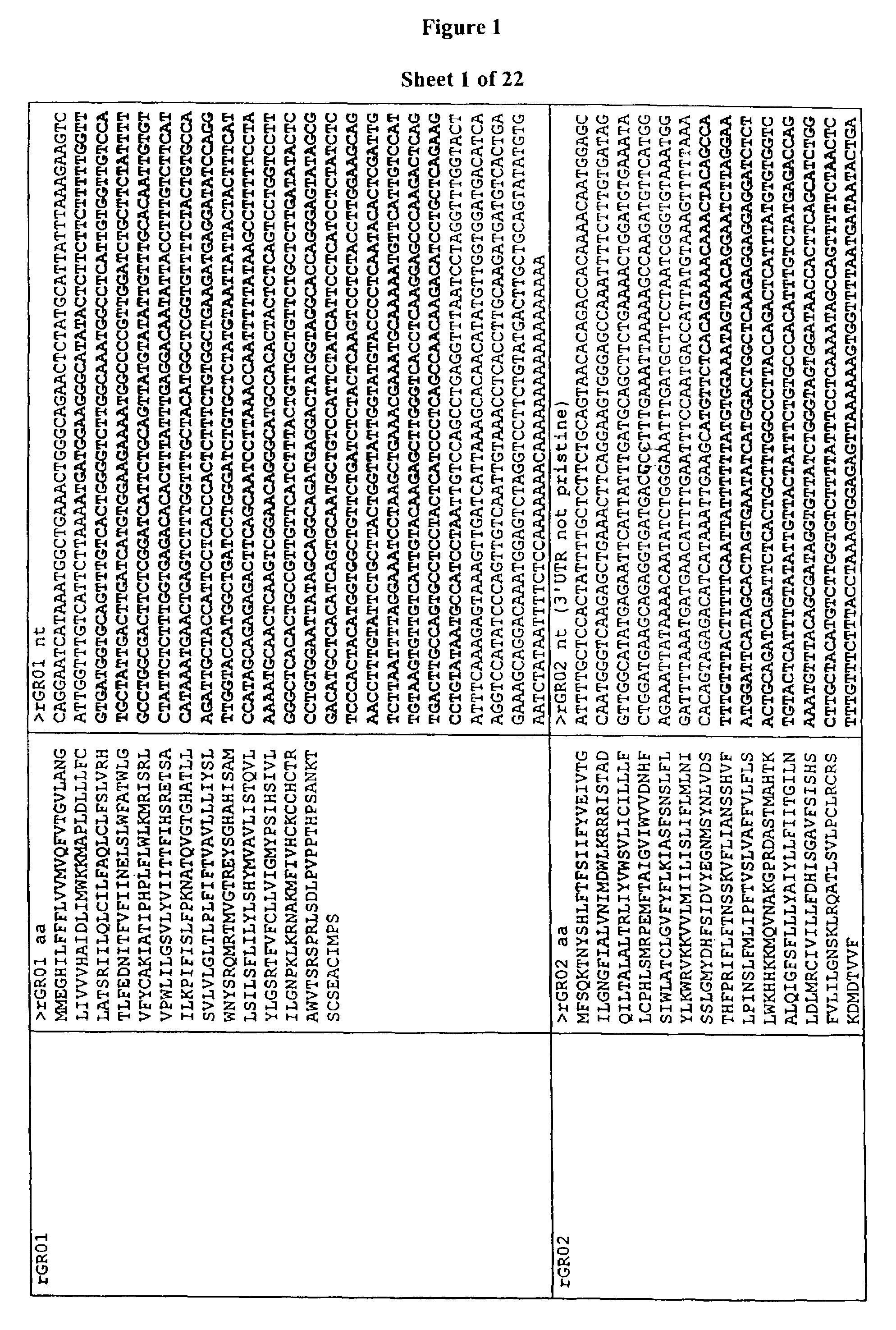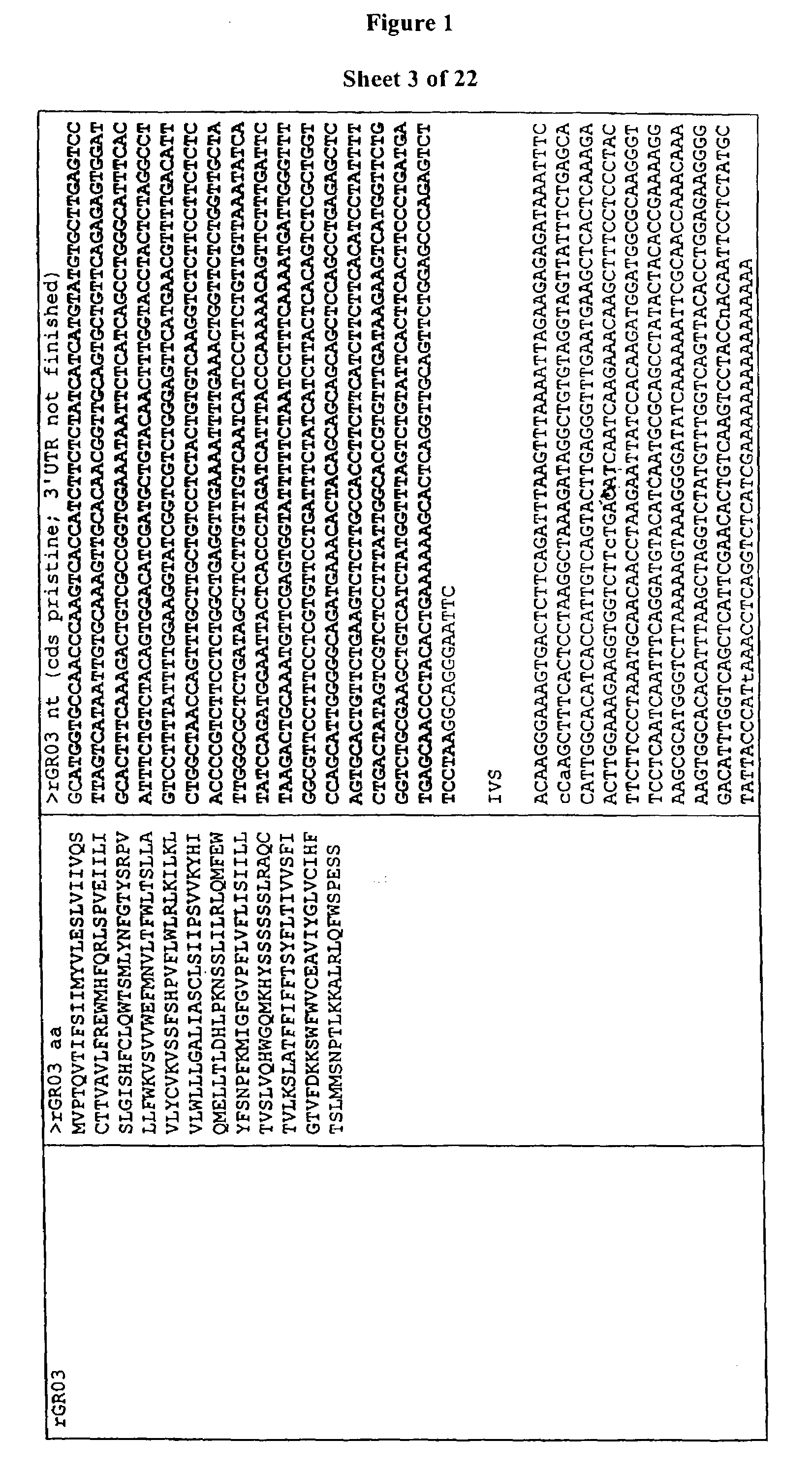Nucleic acids encoding T2R of taste receptors
a technology of gprotein coupled receptors and nucleic acids, which is applied in the field of isolating nucleic acids and amino acid sequences of taste cell specific gprotein coupled receptors, can solve the problem that little is known about the specific membrane receptors involved in taste transduction
- Summary
- Abstract
- Description
- Claims
- Application Information
AI Technical Summary
Problems solved by technology
Method used
Image
Examples
examples
[0292]The following examples are provided by way of illustration only and not by way of limitation. Those of skill in the art will readily recognize a variety of noncritical parameters that could be changed or modified to yield essentially similar results.
example i
Identification of Human SF01
[0293]Human psychophysical tasting studies have shown that humans can be categorized as tasters, non-tasters, and super-tasters for the bitter substance PROP (Bartoshut et al., Physiol Behav 58:2994). The genetic locus involved in PROP tasting has been mapped to human interval 5p15 (Reed et al., 1999 Am. J. Hum. Genet. 64). Using DNA sequences from this genomic area (using information provided by the National Center for Biotechnology Information website: ncbi.nim.nih.gov), a computational analysis was performed to identify novel open reading frames (ORFs) in this interval. The identification of ORFs was facilitated using various programs such as ORF finder, genefinder, fgenesh, etc. (See, e.g., dot.imgen.bcm.tmc.edu). All ORFs larger than 100 amino acids were compared against public databases using BLAST (see, e.g., the National Center for Biotechnology Information), and genes with sequences related to known GPCRs were chosen for further analysis. Candida...
example ii
Identification of the T2R Gene Family
[0294]To identify additional T2R genes, sequence databases were searched for sequences homologous to the human SF01 sequence. Using this screening paradigm, a novel family of GPCRs was identified that includes two genomic clusters of 4 and 9 genes, as well as a number of single loci (see, FIG. 1). A dendogram of various T2R family members is shown as FIG. 2.
[0295]The two gene clusters were mapped to human regions 12p13 and 7q31, respectively. Using the Jackson laboratory databases of mouse genetics (see, e.g.,website informatics.jax.org), and the human / mouse homology maps from the National Center for Biotechnology Information (NCBI) (website: ncbi.nlm.nih.gov / Homology), the T2R cluster at 12p13 was found to correspond to a cluster of bitter-tasting loci in mice. This chromosomal interval has been proposed to include genes involved in the detection of various bitter substances, including sucrose octaacetate (soa), ruffinose acetate (roa), cyclohex...
PUM
| Property | Measurement | Unit |
|---|---|---|
| Tm | aaaaa | aaaaa |
| temperature | aaaaa | aaaaa |
| temperature | aaaaa | aaaaa |
Abstract
Description
Claims
Application Information
 Login to View More
Login to View More - R&D
- Intellectual Property
- Life Sciences
- Materials
- Tech Scout
- Unparalleled Data Quality
- Higher Quality Content
- 60% Fewer Hallucinations
Browse by: Latest US Patents, China's latest patents, Technical Efficacy Thesaurus, Application Domain, Technology Topic, Popular Technical Reports.
© 2025 PatSnap. All rights reserved.Legal|Privacy policy|Modern Slavery Act Transparency Statement|Sitemap|About US| Contact US: help@patsnap.com



